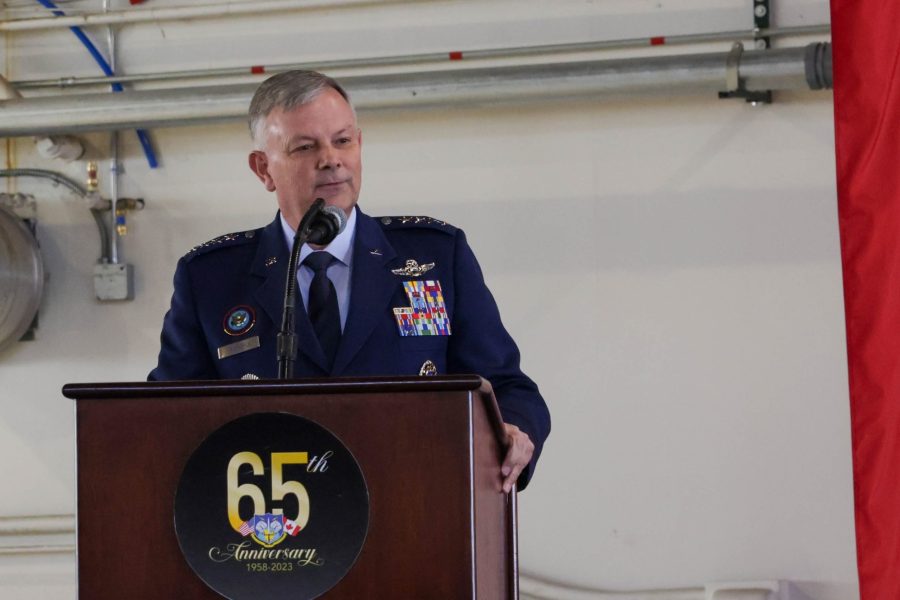The U.S. must focus on detecting and tracking potential air and missile threats to the homeland even before they launch, said Gen. Glen D. VanHerck, head of U.S. Northern Command and North American Aerospace Defense Command.
VanHerck said changing that means homeland defense to “look vastly differently than it does today.” Understanding the threats to homeland defense took on greater urgency earlier this year when a Chinese surveillance balloon was discovered traversing U.S. and Canadian airspace. VanHerck acknowledged that multiple balloons had slipped past NORAD undetected in recent years.
“Domain awareness needs to feed a globally integrated air and missile defense capability where you can do real-time collaboration,” Vanherck said June 22, as AFA’s Mitchell Institute for Aerospace Studies rolled our a new report on Arctic defense. “Think of JADC2, and you can do that with allies and partners so they can generate effects forward for me.
“It also involves getting away from competition with my fellow combatant commanders for fighters or AWACS or tankers, and getting unmanned autonomous platforms with domain awareness capabilities with effectors that are both kinetic and non-kinetic, that we can think of as airborne but also maritime, that we can utilize in the Arctic or we could utilize off the eastern seaboard, the western seaboard, or around the globe wherever we need to be.”
Collaboration across military services, government agencies, and also among allies will be crucial to ensure they can collectively stay “left of launch”—that is, track preparations for threats to arm key decision-makers with more options and more time to decide which to employ.
Gathering and processing data faster with the help of artificial intelligence will also buy time, VanHerck agreed. Dr. Caitlin Lee, who authored the Mitchell Institute report, said: “We need to improve Arctic surveillance or domain awareness now so that decision makers have the information they need to dissuade actors from launching these cruise missile attacks in the first place.”
Asked whether defense of the Arctic requires more data or more processing power, VanHerck indicated he needed more of both—and then more on top of that. Getting allies to work together seamlessly is no less challenging.
“It’s a cultural problem and a policy problem as well, to be able to be comfortable with sharing data and information data that currently is stovepiped,” Van Herck said. Reasons range “sometimes, “from policy or legal considerations within either the intel community” as well as security concerns about allies’ networks. Sometimes, VanHerck said, “we can’t share with allies and partners or receive because they haven’t made their systems resilient enough and secure enough that we trust those things.”
Such issues were laid bare by the Chinese spy balloon incident. VanHerck said U.S. radars have the capability to detect and track objects like the balloon, but NORTHCOM and NORAD had been filtering that data out and therefore didn’t pick up on the balloon right away. And the previous balloons that went undetected were identified by the intelligence community, but the military didn’t find out until after the fact.
The balloon that eventually transited the entire continental U.S. was detected over Alaskan islands near the Arctic—highlighting the region’s increased strategic value.
“It’s a vast expanse and it’s increasing in its importance each and every day with environmental change, commercial travel, access to resources,” VanHerck said. “And all of those create opportunities and they create vulnerabilities. It’s the shortest path to our homeland from potential adversaries, such as [China] or Russia, and now there’s more access and opportunity there which will create the potential for strategic competition. So the importance of the Arctic can’t be overstated, candidly.”
There are many things the Pentagon can do to realize VanHerck’s long-term vision for enhanced security in the region. In the short term, though, Lee recommended in her report that:
- Congress create a “North American Deterrence Initiative”
- The Air Force increase funding to field new over-the-horizon radars in the Arctic faster
- The Air Force establish a rotational drone presence in the Arctic
- The Air Force increase funding to field the new E-7 Wedgetail faster and keep legacy fighters
- The Air Force, Space Force, and the rest of government work more closely with commercial industry and allies and partners
VanHerck, for his part, noted that there may be policy issues that need to be resolved to ensure drones, especially future autonomous drones, could fly in the region. But on the whole, he endorsed the suggestions.
“I concur with the recommendations that Dr. Lee made,” said VanHerck, who is set to retire soon and be succeeded by Air Force Lt. Gen. Gregory M. Guillot. “I think there’s some great recommendations there.”
